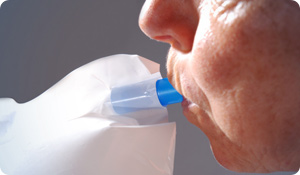
Preliminary studies using breath tests to identify patients with cancer may provide another option for doctors. So far, results show promise for detecting at least lung and breast cancers. Early detection of cancer is critical. Catching tumors before they spread increases the likelihood treatment will be successful, so physicians need more accurate screening tools.
How Cancer Breath Tests Work
These breath tests detect elevated levels of volatile organic compounds, VOCs, in patients with cancer. Many solids and liquids, such as cleaning supplies, pesticides, building materials, and adhesives emit VOCs as gases. VOCs are harmful to our health and contribute to air pollution.
Scientists have identified roughly 200 VOCs in the human breath. When something harmful, such as tobacco, stresses our body, it causes oxidative stress, which results from the toxic effects of oxygen free radicals (unstable molecules). Oxidative stress can cause disease and accelerate aging. When you consume antioxidants from fresh fruits and vegetables, it neutralizes free radicals.
Early Results
Lung cancer patients have elevated VOCs that arise from a metabolic pathway in tumor cells. In studies using the most recent iteration of breath tests, scientist use a sensor made from gold nanoparticles (microscopic particles), which distinguishes the breath of cancer patients from healthy patients. Breath tests may even help physicians identify different types of primary lung cancer. Earlier versions of breath tests also had a good success rate in studies, but produced many false positives (abnormal results in the absence of cancer).
Currently there is no acceptable test to screen for lung cancer. The few available procedures are expensive and miss tumors. Furthermore, abnormal results lead to other, often invasive, procedures, which carry significant risks. So far, using existing screening tools does not lower the number of deaths from lung cancer.
More than 200,000 people will develop lung cancer in 2010. Since it's not easy to detect earl, many patients don't learn they have lung cancer until it's advanced and difficult to treat. An effective screening tool for lung cancer could potentially save many lives.
Breast cancer tumors also produce VOCs that serve as markers of oxidative stress associated with breast cancer. Physicians may someday be able to use breath tests to measure these VOCs in conjunction with screening mammography. In a recent pilot study, breath tests were slightly more sensitive than mammograms. An accurate breath test for breast cancer might significantly reduce the high incidence of unnecessary procedures that follow abnormal mammograms.
Breath tests are still in their infancy, but show promise as a tool for inexpensive and accurate cancer screening.
Sources:
Nelson, Roxanne. "'Gold Plated' Breath Test Accurately Diagnoses Lung Cancer." Nature Nanotechnology Published online August 30, 2009. Medscape Medical News. 4 September 2009.
http://www.medscape.com/viewarticle/708428
Boughton, Barbara. "More Sensitive 'Electronic Nose' Detects Lung Cancer From Breath." 13th World Conference on Lung Cancer (WCLC): Abstract B3.5. Presented August 2, 2009. Medscape Medical News. Web. 3 August 2009.
http://www.medscape.com/viewarticle/706865
Singh, Vineeta, Saunders, Christobel, Wylie, Liz, and Bourke, Anita. "New Diagnostic Techniques for Breast Cancer Detection." Future Oncology 4(4) (2008): 501-503. Medscape Medical News. 3 October 2008.
http://www.medscape.com/viewarticle/579916
"Nanoparticle breath test for lung cancer." Chemistry World August 2009. Web. 30 August 2009.
http://www.rsc.org/chemistryworld/News/2009/August/30080902.asp
Paddock, Catharine. "US Scientists Prototype Breath Test For Lung Cancer." Medical News Today. Web. 26 Feb 2007.
http://www.medicalnewstoday.com/articles/63857.php
National Cancer Institute. "What you need to know about lung cancer." Web. 26 July 2007.
http://www.cancer.gov/cancertopics/wyntk/lung
National Cancer Institute. What you need to know about breast cancer." Web. 15 October 2009.
http://www.cancer.gov/cancertopics/wyntk/breast/page6





